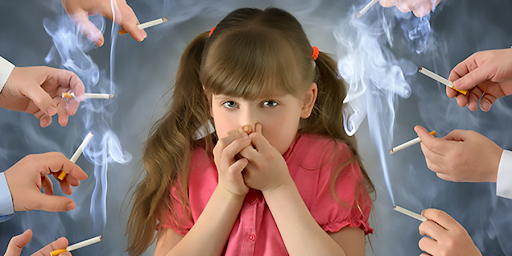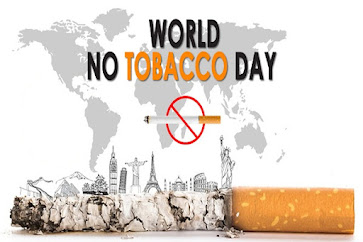Second-hand smoke (SHS) : Hidden Danger as there is no safe level of exposure to secondhand smoke.
Second-hand smoke (SHS)
- Introduction
Second-hand smoke is a mixture of the smoke from the burning tip of a cigarette and the smoke exhaled by a smoker. When second-hand smoke contaminates the air, especially in enclosed spaces, it is inhaled by everyone, exposing both smokers and non-smokers to its harmful effects. It causes lung cancer in non-smokers and increases the risk of coronary heart disease. Second-hand smoke (SHS), which is also called environmental tobacco smoke (ETS), involuntary smoke, and passive smoke, is the combination of “side stream” smoke given off by a burning tobacco product and “mainstream” smoke exhaled by a smoker. Second-hand smoke (SHS)from cigarettes is a known human toxin and carcinogen. SHS is a complex mixture of more than 4,000 compounds and is also referred to as involuntary smoking, tobacco smoke pollution, and passive smoking. Worldwide, 40% of children, 33% of male non-smokers, and 35% of female non-smokers were exposed to second-hand smoke in 2004.
The Global Youth Tobacco Survey (GYTS) in India, coordinated by the Centres for Disease Control, found moderate exposure to second-hand smoke among school students aged 13-15 years. For example, in 2009 one in five students surveyed reported they were exposed to second-hand smoke in their home and more than one-third of the students were exposed to smoke outside of the home. Almost six million people die from tobacco use each year. Of these total deaths, just over 600,000 are attributable to second-hand smoke exposure to non-smokers and more than five million to direct tobacco use (both smoking and smokeless tobacco).
- The harms of second-hand smoke
Females: Women exposed to secondhand smoke may face increased risks of respiratory issues, cardiovascular diseases, and certain cancers. Pregnant women exposed to secondhand smoke are at a higher risk of complications such as preterm birth, low birth weight, and developmental problems in their children.
Children: Secondhand smoke poses severe health risks to children. They are more susceptible to respiratory infections, asthma, ear infections, and sudden infant death syndrome (SIDS). Secondhand smoke exposure can hinder their lung development, impair cognitive function, and lead to long-term health issues.
Adolescents and Youth: Secondhand smoke exposure can influence adolescents and youth to initiate smoking. They may face a higher risk of developing smoking-related behaviors, addiction, and long-term health consequences such as respiratory diseases, cardiovascular problems, and certain cancers.
Senior Citizens: Older adults, particularly those with pre-existing health conditions, are more vulnerable to the negative effects of secondhand smoke. Secondhand smoke can exacerbate respiratory conditions such as COPD, asthma, and increase the risk of heart disease and stroke. It can also compromise their immune system, making them more susceptible to infections.
Protecting these vulnerable populations from secondhand smoke is crucial. Implementing smoke-free policies in public spaces, homes, and vehicles can help reduce their exposure. Additionally, promoting smoking cessation programs, raising awareness about the dangers of secondhand smoke, and providing support for quitting smoking can contribute to better health outcomes for females, children, adolescents, youth, and senior citizens. Creating smoke-free environments is essential for safeguarding their health and improving their overall well-being.
- India:
- Global:
Framework Convention on Tobacco Control (FCTC): The World Health Organization's FCTC is an
international treaty aimed at reducing tobacco consumption and exposure to secondhand smoke.
It has been ratified by numerous countries worldwide and encourages the implementation of
comprehensive smoke-free legislation.
Graphic Health Warnings: Many countries require graphic health warnings on cigarette packages
to educate consumers about the harmful effects of smoking and discourage tobacco use.
It's important to note that specific smoking restrictions may vary from country to country, and even within different regions of a country. The extent and enforcement of these laws depend on local regulations and policies. It is advisable to consult the specific laws and regulations in your own country or region for the most accurate and up-to-date information on smoking restrictions in public places.
Prevention: Non-smokers need to be protected from secondhand smoke exposure within the
home, at school and in the workplace. Women and children often do not have the power to
negotiate smoke-free spaces, even within their own homes. Some workers are obliged to spend
most of their work time in a health-threatening environment.
There is no safe level of exposure to secondhand smoke.
- Non-smokers, including women and children, have a right to breathe tobacco-free clean air.
- Ventilation or designated smoking-rooms do not offer effective protection.
- All indoor workplaces, public transport, schools and health services should be smoke free.
- People need to be better informed of the hazards of second-hand smoke to themselves, fetuses, children and other family members.
- Study of Secondhand Smoke Levels Pre and Post Implementation of the Comprehensive Smoking Ban in Mumbai Aditi Deshpande, Priyanka Kudtarkar, Dhanashri Dhaware, Rohini Chowgule.
- Determinants of exposure to second-hand smoke at home and outside the home among students aged 11-17 years: Results from the Mumbai Student Tobacco Survey 2010. Raute LJ, Pednekar MS, Mistry R1, Gupta PC, Pimple SA2, Shastri SS
- Fact sheet. Global Youth Tobacco Survey (GYTS), India, 2009. Available from: http://www.who.int/fctc/reporting/Annexoneindia.pdf. [Last accessed on 2012 Jul 16].
- World Health Organization (WHO). Global Health Risks: Mortality and Burden of Disease Attributable to Selected Major Risks. Geneva: World Health Organization, 2009.
- The Prohibition of Smoking in Public Places, 2008. The Gazette of India, Ministry of Health and Family Welfare; Notification G.S.R. 417 (E) No. 304






Comments
Post a Comment